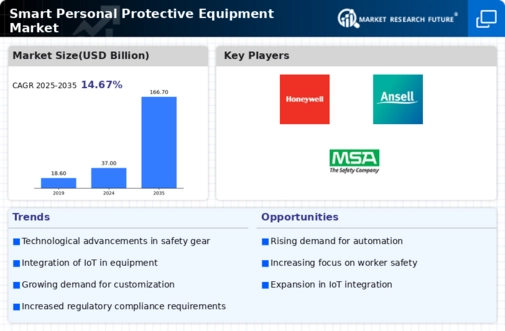Integration of Advanced Technologies
The Smart Personal Protective Equipment Market is witnessing a notable shift towards the integration of advanced technologies such as artificial intelligence and machine learning. These technologies enhance the functionality of personal protective equipment by enabling real-time data analysis and predictive analytics. For instance, smart helmets equipped with augmented reality can provide users with critical information about their surroundings, thereby improving safety. The market for smart helmets alone is projected to reach USD 1.5 billion by 2026, indicating a robust growth trajectory. This integration not only enhances user safety but also streamlines operational efficiency, making it a pivotal driver in the Smart Personal Protective Equipment Market.
Growing Awareness of Workplace Safety
There is an increasing awareness of workplace safety among employers and employees, which is driving the Smart Personal Protective Equipment Market. Organizations are recognizing the importance of providing their workforce with advanced protective gear to mitigate risks and enhance safety. This heightened awareness is reflected in the rising investments in safety training and equipment. According to recent data, the global market for personal protective equipment is expected to grow at a CAGR of 7.5% from 2023 to 2030. This trend indicates a strong commitment to safety, thereby fueling the demand for smart personal protective equipment that offers enhanced features and functionalities.
Technological Advancements in Materials
The Smart Personal Protective Equipment Market is benefiting from technological advancements in materials used for manufacturing protective gear. Innovations such as lightweight, breathable fabrics and impact-resistant composites are enhancing the performance and comfort of smart personal protective equipment. These advancements not only improve user experience but also increase the durability and effectiveness of the equipment. For instance, the introduction of smart textiles that can monitor physiological parameters is revolutionizing the market. As these materials become more prevalent, they are likely to attract a broader consumer base, thereby driving growth in the Smart Personal Protective Equipment Market.
Regulatory Compliance and Safety Standards
The Smart Personal Protective Equipment Market is significantly influenced by stringent regulatory compliance and safety standards imposed by various governing bodies. These regulations mandate the use of advanced protective gear in high-risk industries such as construction, manufacturing, and healthcare. As organizations strive to meet these standards, the demand for smart personal protective equipment is expected to rise. For example, the Occupational Safety and Health Administration (OSHA) has set forth guidelines that encourage the adoption of innovative safety solutions. This regulatory landscape is likely to propel the market forward, as companies invest in smart equipment to ensure compliance and enhance worker safety.
Increased Investment in Research and Development
Investment in research and development is a crucial driver for the Smart Personal Protective Equipment Market. Companies are allocating significant resources to innovate and develop new products that meet the evolving needs of users. This focus on R&D is leading to the creation of smarter, more efficient personal protective equipment that incorporates features such as connectivity and real-time monitoring. As organizations seek to enhance safety and productivity, the demand for innovative solutions is expected to rise. The market is projected to witness a surge in new product launches, further propelling growth in the Smart Personal Protective Equipment Market.


















Leave a Comment